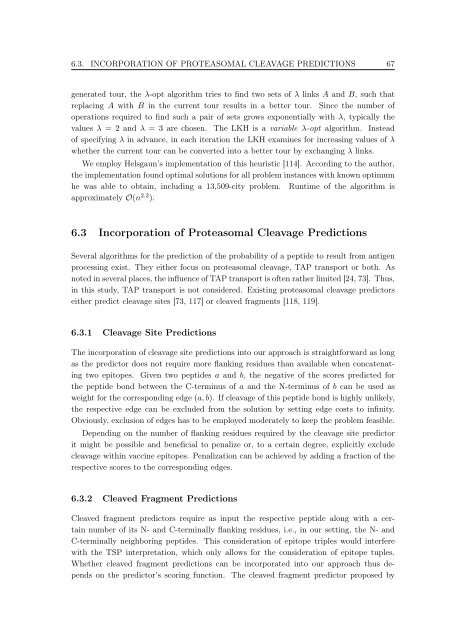New Approaches to in silico Design of Epitope-Based Vaccines
New Approaches to in silico Design of Epitope-Based Vaccines
New Approaches to in silico Design of Epitope-Based Vaccines
Create successful ePaper yourself
Turn your PDF publications into a flip-book with our unique Google optimized e-Paper software.
6.3. INCORPORATION OF PROTEASOMAL CLEAVAGE PREDICTIONS 67<br />
generated <strong>to</strong>ur, the λ-opt algorithm tries <strong>to</strong> f<strong>in</strong>d two sets <strong>of</strong> λ l<strong>in</strong>ks A and B, such that<br />
replac<strong>in</strong>g A with B <strong>in</strong> the current <strong>to</strong>ur results <strong>in</strong> a better <strong>to</strong>ur. S<strong>in</strong>ce the number <strong>of</strong><br />
operations required <strong>to</strong> f<strong>in</strong>d such a pair <strong>of</strong> sets grows exponentially with λ, typically the<br />
values λ = 2 and λ = 3 are chosen. The LKH is a variable λ-opt algorithm. Instead<br />
<strong>of</strong> specify<strong>in</strong>g λ <strong>in</strong> advance, <strong>in</strong> each iteration the LKH exam<strong>in</strong>es for <strong>in</strong>creas<strong>in</strong>g values <strong>of</strong> λ<br />
whether the current <strong>to</strong>ur can be converted <strong>in</strong><strong>to</strong> a better <strong>to</strong>ur by exchang<strong>in</strong>g λ l<strong>in</strong>ks.<br />
We employ Helsgaun’s implementation <strong>of</strong> this heuristic [114]. Accord<strong>in</strong>g <strong>to</strong> the author,<br />
the implementation found optimal solutions for all problem <strong>in</strong>stances with known optimum<br />
he was able <strong>to</strong> obta<strong>in</strong>, <strong>in</strong>clud<strong>in</strong>g a 13,509-city problem. Runtime <strong>of</strong> the algorithm is<br />
approximately O(n 2.2 ).<br />
6.3 Incorporation <strong>of</strong> Proteasomal Cleavage Predictions<br />
Several algorithms for the prediction <strong>of</strong> the probability <strong>of</strong> a peptide <strong>to</strong> result from antigen<br />
process<strong>in</strong>g exist. They either focus on proteasomal cleavage, TAP transport or both. As<br />
noted <strong>in</strong> several places, the <strong>in</strong>fluence <strong>of</strong> TAP transport is <strong>of</strong>ten rather limited [24, 73]. Thus,<br />
<strong>in</strong> this study, TAP transport is not considered. Exist<strong>in</strong>g proteasomal cleavage predic<strong>to</strong>rs<br />
either predict cleavage sites [73, 117] or cleaved fragments [118, 119].<br />
6.3.1 Cleavage Site Predictions<br />
The <strong>in</strong>corporation <strong>of</strong> cleavage site predictions <strong>in</strong><strong>to</strong> our approach is straightforward as long<br />
as the predic<strong>to</strong>r does not require more flank<strong>in</strong>g residues than available when concatenat<strong>in</strong>g<br />
two epi<strong>to</strong>pes. Given two peptides a and b, the negative <strong>of</strong> the scores predicted for<br />
the peptide bond between the C-term<strong>in</strong>us <strong>of</strong> a and the N-term<strong>in</strong>us <strong>of</strong> b can be used as<br />
weight for the correspond<strong>in</strong>g edge (a, b). If cleavage <strong>of</strong> this peptide bond is highly unlikely,<br />
the respective edge can be excluded from the solution by sett<strong>in</strong>g edge costs <strong>to</strong> <strong>in</strong>f<strong>in</strong>ity.<br />
Obviously, exclusion <strong>of</strong> edges has <strong>to</strong> be employed moderately <strong>to</strong> keep the problem feasible.<br />
Depend<strong>in</strong>g on the number <strong>of</strong> flank<strong>in</strong>g residues required by the cleavage site predic<strong>to</strong>r<br />
it might be possible and beneficial <strong>to</strong> penalize or, <strong>to</strong> a certa<strong>in</strong> degree, explicitly exclude<br />
cleavage with<strong>in</strong> vacc<strong>in</strong>e epi<strong>to</strong>pes. Penalization can be achieved by add<strong>in</strong>g a fraction <strong>of</strong> the<br />
respective scores <strong>to</strong> the correspond<strong>in</strong>g edges.<br />
6.3.2 Cleaved Fragment Predictions<br />
Cleaved fragment predic<strong>to</strong>rs require as <strong>in</strong>put the respective peptide along with a certa<strong>in</strong><br />
number <strong>of</strong> its N- and C-term<strong>in</strong>ally flank<strong>in</strong>g residues, i.e., <strong>in</strong> our sett<strong>in</strong>g, the N- and<br />
C-term<strong>in</strong>ally neighbor<strong>in</strong>g peptides. This consideration <strong>of</strong> epi<strong>to</strong>pe triples would <strong>in</strong>terfere<br />
with the TSP <strong>in</strong>terpretation, which only allows for the consideration <strong>of</strong> epi<strong>to</strong>pe tuples.<br />
Whether cleaved fragment predictions can be <strong>in</strong>corporated <strong>in</strong><strong>to</strong> our approach thus depends<br />
on the predic<strong>to</strong>r’s scor<strong>in</strong>g function. The cleaved fragment predic<strong>to</strong>r proposed by

















